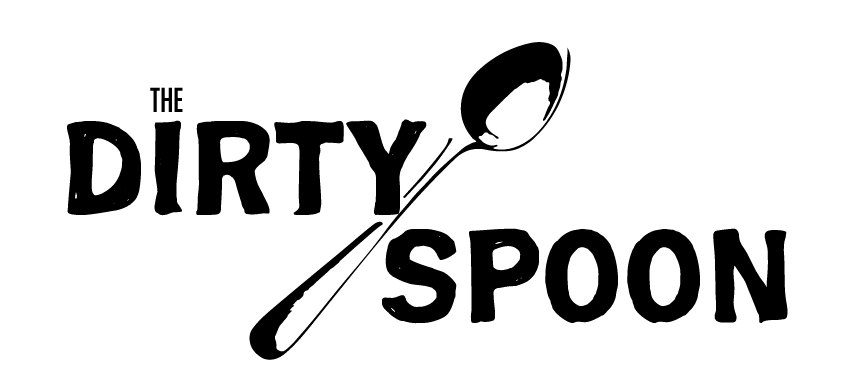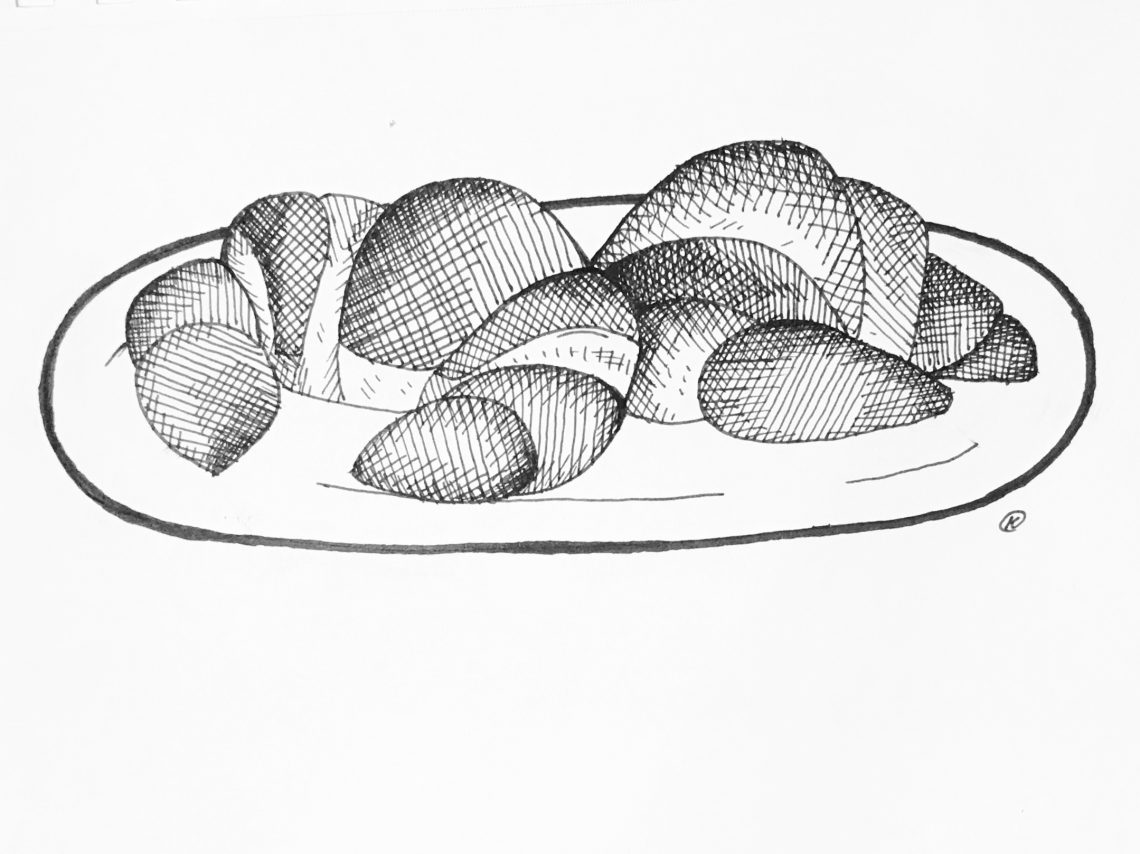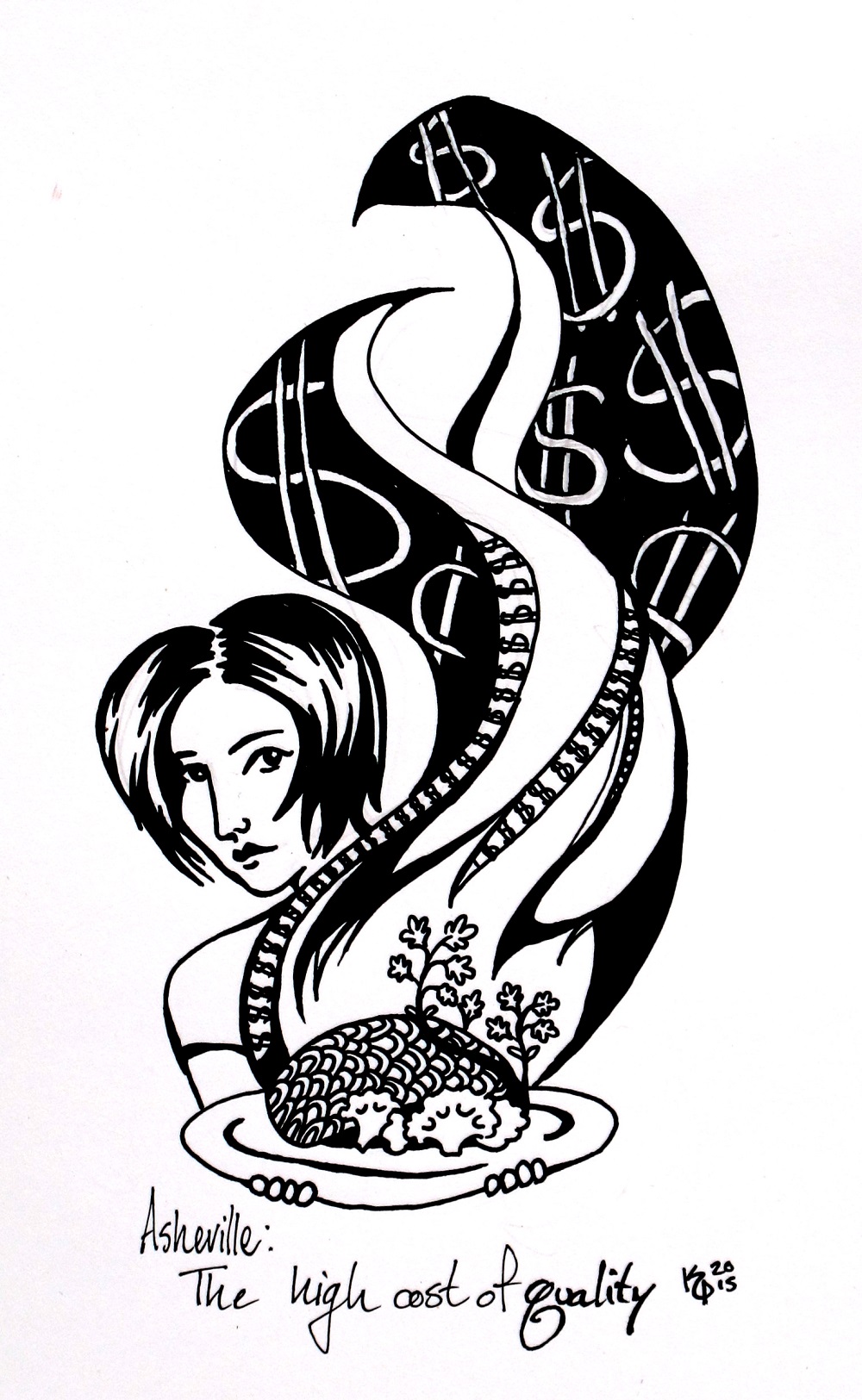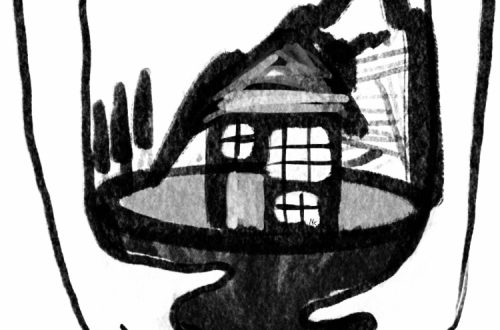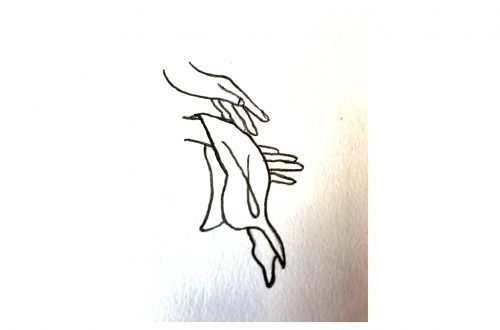by Jordana Rosenfeld
Art by Kelly Minear
Jordana’s essay, “Dark Crusts,” appears in Episode 9 of The Dirty Spoon Radio Hour, which originally aired January 4, 2019.
There were so many things about working at a bakery that I loved.
The marvel of creating such vast quantities of food – several hundred pounds of cookie dough and muffin batter each week, several hundreds of loaves: baguettes, dense and flavored sourdough, braided challah, seeded fougasse, pan-bound loaves of “French” bread. The sense of accomplishment that came from turning water from the tap, yeast from the walk-in fridge, and flour from the white, wheeled trash cans under our work table into hundreds of loaves of bread. The way that making fresh bread is a never ending task: there is always a market for fresher bread. Each afternoon, hour, and day brings with it renewed potential for freshness. How strong I felt hoisting 50 pound bags of flour onto the table, slitting the paper bag with a bread knife, and pouring it into the plastic can below, even though my body ached nearly every day from this labor that was essentially my only form of exercise.
There were also things about working at a bakery that I merely tolerated.
The early hours, the heat that ensured my constant sweat, the customer service. Although I was hired to bake, I often pitched in to cover last minute absences at the front counter. I liked it because it was less physically strenuous than baking and I got paid my comparatively higher baker’s wage to do it. Most of our customers were excellent – kind, if not friendly, then at least efficient, good at communicating their desires. Some customers had corny jokes they repeated ad nauseum, some had subtly fatphobic comments about how they’d never be able to maintain their weight if they had my job. I smiled and laughed, because it was my job. Most of our customers weren’t especially picky, but some were. Well aware that it was also my job to cater to customer specifications rather than judge them, I nonetheless began to notice a disturbing pattern among our choosy customers. I realized that, when it came to any one of our offerings, from the meticulously laminated croissants to the streusel-topped apple tarts to every style of our loaves, there existed an outspoken customer contingent that wanted their baked goods to be of the palest hue.
“Can I get five of your lightest croissants?”
The first time I heard this request, from the earnest face of one of our regular customers, an older white woman in a Patagonia down jacket with reading glasses perched on her nose and gemstones on her fingers and in her ears, I was baffled.
“Lightest, like in terms of weight?” I asked, unclear as to why someone would want to get a pastry with less mass, given that we don’t price by weight.
“No, like not dark. I don’t like those darker ones.”
To my eye, there was no great variation in our croissant color. They all looked golden brown. My hand hovered over a pastry as I tilted the tray down so she could see it.
“Is this one good?”
“Yes, and the one right next to it.”
Sometimes, I had already packaged a customer’s order when they would open it and say, “I don’t want this loaf, it’s too dark.”
I invariably replaced it and kept my scorn to myself.
It turns out that this desire for light-colored baked goods is not unique to my old bakery.
“Dark-crusted bread is a novelty in this country,” says master baker Mark Furstenberg, of Washington D.C.’s Bread Furst bakery, who is often credited with introducing European-style breads to the area. Furstenberg reports incessant complaints from customers that he’s overcooking his bread or “baking dark.”
According to the founder of Zingerman’s Delicatessen, Ari Weinzweig, “One of my longest-running challenges has been to persuade people that dark-crusted breads are better. From a selling standpoint, they usually spell doom. Americans have been led to believe over the years that darker crusts are undesirable, a sign of a bad baker pawning off overbaked loaves on an innocent consumer. Dozens of bakers around the country as well as countless Zingerman’s staffers have told me that customers just won’t buy darker loaves.”
Bread could be considered “dark” because it’s baked with a darker colored flour, such as whole grain, rye, pumpernickel or teff flours and/or because the loaf has spent more time in the oven. My anecdotal experience is that white bread sells so much better than dark bread that one shouldn’t even bother producing the same amount of each and that even (or perhaps especially) when it comes to two otherwise identical loaves of white bread, the loaf with the lighter crust is considered more desirable.
Is there actually a meaningful, qualitative difference between light crusted bread and dark crusted bread? Someone may prefer a lighter crust if they require a softer, less crunchy bread experience; it’s true that not everyone has the bite required to tear into a crusty, dark loaf insofar as more time in the oven renders a crust more tough. Bakers who prefer darker crusted bread often argue it’s more flavorful. In the case of fermented breads like sourdough, darker bakes could be more flavorful because longer fermentation periods allow grains to release all their sugars, providing for a caramelized crust. This argument does reinforce the perception that there’s a significant taste difference between dark and light crusts.
Despite those points, it’s likely the most significant difference between light and dark crusts has to do with perception rather than empirical reality.
Despite those points, it’s likely the most significant difference between light and dark crusts has to do with perception rather than empirical reality. There is the perception that oven-darkened items are burnt, and therefore higher in carcinogens. It’s valid to want to avoid eating burnt food – the problem there is that an item set out for sale at an established bakery is almost certainly not burnt. I find it incredibly hard to believe that a professional baker or bakery owner would ever choose to sell burnt bread – bread is just not that expensive to make, and all of the bakers I know are fastidious in their pursuit of high quality loaves. To me, accusations that dark crusted bread is burnt evidence the intense strength of our collective aversion to darker baked goods – many consumers view darker crusts as so undesirable that they conflate perfectly good, darker loaves with inedible loaves.
The most significant reason, in my opinion, that customers tend to perceive lighter colored bread more positively than darker colored bread, since it’s impossible for anything human to exist outside of the value systems we have built to structure our world, is the pernicious influence of white supremacy. Differences in bread consumption have long mapped onto hierarchies of power. Historian Aaron Bobrow-Strain, in his book on the history of white bread, writes, “In most times and places throughout history, the social order of bread arrayed itself in a spectrum from the lightest, whitest, and most wheaten for elites to darker, chewier, and more admixed loaves for the rest.” This distinct relationship between bread and power means that certain types of bread can easily become associated with certain types of people.
Differences in bread consumption have long mapped onto hierarchies of power.
In American society, our hierarchies of power have always been racialized, with light skinned people at the top and dark skinned people at the bottom; there is significant historical precedent for projecting racism and xenophobia onto bread. Some historians argue that the initial popularity of Wonder Bread, for example, was propelled by anti-immigrant anxieties. At the turn of the 20th century, most bread was produced by local bakeries. By the 1930s, most Americans bought bread made in factories. That shift was propelled in large part by concerns about hygiene; earlier in the century, local bakeries were often staffed by recent immigrants from southern or eastern Europe who were perceived as unclean.
As factory-made white bread like Wonder Bread was gaining in popularity, writes Bobrow-Strain, “It would have been almost impossible to escape the message, conveyed by food advertising, scientific studies, political cartoons, foreign correspondents, and even church sermons, that only savage peoples and unwashed immigrants ate dense, dark bread.” White bread was even said to “Americanize” new immigrants to the U.S.
Wonder Bread bears slightly different connotations today, but our fundamental white supremacist structures have not changed, and neither has the relationship between bread and power. Given the racist history of white bread and its longstanding negative biases against dark bread, it seems quite likely that people continue to apply a white supremacist lens, in which light-equals-good and dark-equals-bad, to today’s bread. This logic also appears to live on in today’s Americans’ poultry preferences. Americans markedly prefer white meat chicken and turkey to dark meat, according to Slate, NPR, and Forbes, although perceptions of white meat’s nutritional superiority are not borne out by scientific evidence.
Perceptions of food (often based on color and appearance) have a significant impact on our experience of taste and flavor.
Additionally, a growing body of scientific evidence suggests that, when it comes to food, our expectations generate our reality. Perceptions of food (often based on color and appearance) have a significant impact on our experience of taste and flavor, according to the journal Flavour, which reports, “Colour is the single most important product-intrinsic sensory cue when it comes to setting people’s expectations regarding the likely taste and flavour of food and drink.” According to this article, these pre-consumption expectations are automatic, occurring on the level of implicit bias.
What some view as taste-based preference (and therefore exempt from moral scrutiny) may in fact be a psychological bias.
The customer who claims to prefer light crusts simply because they taste better than dark crusts could very well be operating on a psychological bias unconsciously adopted over a lifetime of exposure to a white supremacist culture.
If it’s true that white supremacy inflects more of our decision making than we know or care to know, what then?
While my first impulse is always to validate all people’s lived experiences and any resultant preferences, my second impulse is to ask, “Why?” Is someone’s preference less valid if it’s based on racist logic? If our goal is to build an anti-racist society, then the answer has to be yes. How would operationalizing that conclusion change our relationship to our food?
original artwork by Kelly Minear.

Jordana Rosenfeld is a freelance writer and journalist living in Pittsburgh, PA. Her day job is community outreach in post-industrial communities along the Monongahela river, and her goal for 2019 is to have her work rejected by 25 different publications. Find her on Twitter @rosenfeldjb
